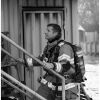If you had to select the current hottest topic in the fire service, cancer prevention would be near the top of the list. The data and statistics are both scary and undeniable: Cancer is spreading throughout the fire service membership at an alarming rate. Today, organizations that have not had an employee who has – or is currently battling – the disease are in the minority. In our own municipality, we have had three within the last five years.
Myrtle Beach’s decon protocol
We know that toxins are around us in many of our fireground activities, so what steps should we take? Our jobs have risk, and we continue to be exposed to carcinogens because they are unavoidable in our arena of work. Arguably, the biggest impact for our people will be the actions that you take right after the firefighting is over. The bottom line is that you need to do something.
The process currently in use by the Myrtle Beach (South Carolina) Fire Department is not a cutting-edge concept; it is simple to follow and can be implemented anywhere. It focuses on a rapid gross decontamination for our members immediately after their exposure to the immediately dangerous to life and health (IDLH) environment. We attack the known areas of carcinogen absorption through the skin in a sequence of steps. These practices have a nominal cost to the organization, and based on the corresponding data, are significantly effective. The policy has been in place for only a few years, which required a combination of a cultural change and increased awareness from our team.
Step 1: PPV fans help remove contaminants
The first step in our decontamination is the use of a positive-pressure ventilation (PPV) fan. While still breathing from their SCBA, members are instructed to stand in front of the running fan for a short period of time. This helps assist with the removal of contaminants from the PPE and reduces toxic vapors due to the movement of passing air. The fan is quick and can gross-decontaminate a company of firefighters within a minute or two. This is especially important in the event that the company needs to return to service immediately to complete an additional task.
Step 2: Crewmembers are hosed off
Next, the crewmembers are hosed off. We recommend the use of a small booster line or garden hose off an adapter, as the intent is not to saturate the turnout gear. If an exterior hoseline the only available choice, then it will suffice. A note for the nozzle operator: You need to only crack open the bail to achieve the sufficient stream to wash away the contaminants. The first-due engine’s driver/operator is a good person to assist, if available.
Step 3: Flash hoods are collected
The company officer, or the shift’s safety officer will then collect the flash hoods of the members who completed this step of the process. A clean flash hood will then be distributed to the personnel. In the event that the company needs to re-enter the IDLH, at least the clean hood will reduce the skin absorption through the neck. This exchange requires a cache of clean hoods available as well as some accountability, as someone has to play the role of flash hood collector. The collected flash hoods are then bagged and laundered to replace the stock of hoods needed for future incidents. The downtime for cleaning is a weakness here, as it can take a little time for the hoods to be washed and dry. However, the goal is to help those in the moment, and to not focus on the needs of the possible next event.
Step 4: Baby wipes cleanse the skin
Finally, baby wipes are carried in all the suppression apparatus. The company is instructed to use the wipes to clean their hands, neck, and face. This act is the first step in cleaning the member’s skin and decontaminating the person, rather than the PPE.
Step 5: Additional cleaning of PPE and personnel
The remainder of the PPE is then removed and stored in a separate location from the cab as the crew returns to their station out of service to shower.
Quick decon is the key
These are basic steps of the Myrtle Beach Fire Department’s post-incident cancer reduction methods policy. The overall goal is a quick decontamination that reduces exposures while getting members back to service quickly.
Note: Myrtle Beach Lt. Adam Oleszkowicz contributed to this article.



